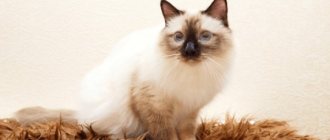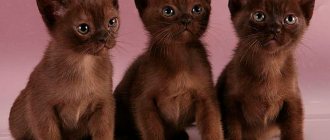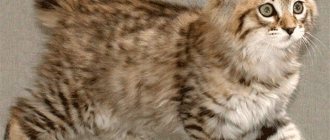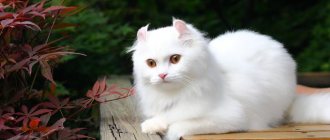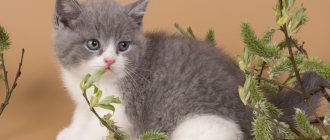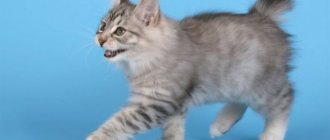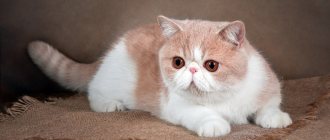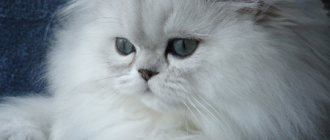In the material, we examined the American Bobtail cat breed, the history of its appearance, external features and character, rules of nutrition and care. You will also learn the pros and cons of the breed, and also learn how to choose a kitten of this breed.
Brief history of the breed
The history of the American Bobtail began not so long ago: in the 1960s of the 20th century. The Sanders couple were returning home along the road from an Indian reservation in Southern Arizona. On the way, they met an unusual kitten who had a “bunny” tail: short, knotty and curved upward.
In the photo, a characteristic external feature of the breed is a short, broken tail.
The young people were captivated by the kitten, which subsequently crossed with a Siamese cat. The new “parents” brought kittens into their litter, one of which was the spitting image of their dad – just as short-tailed and fluffy. It was clear that the short-tailed feature was transmitted genetically. This discovery marked the beginning of breeding work to develop a new breed - the American Bobtail, the cats of which have received worldwide recognition among cat lovers around the world.
IMPORTANT: scientists have put forward the opinion that the American bobtail is the result of a genetic mutation of ragdolls or crossing the Japanese bobtail, lynx and Manx cats. So far this fact remains unconfirmed.
The breed standard was established in early 1970, and the breed itself was recognized in 1989. Cats of this breed are bred in North America; it is extremely difficult to buy an American Bobtail kitten outside the states.
American Bobtail – a born Yankee
Origin story
The distant ancestors of the American Bobtail lived in North America for many years. But the peak of popularity and the formation of the breed as such occurred relatively recently - in the 60s. It was in those years that the Sanders couple, walking through the Indian reservation in Southern Arizona, came across a desperately meowing ball. They took the baby with them. Short-tailed, chocolate tabby-colored baby Yodi was transported to Iowa, and when he grew older, he was introduced to a neighbor's Siamese cat.
The owners were pleased and surprised by the first litter - one of the kittens had exactly the same short tail as a bunny’s, cockily curved upward.
The first attempts at breeding were unsuccessful: the Sanders had no experience and did not know the genetic rules, so they tried to breed cats with each other in order to prevent the offspring from degenerating. The result was completely opposite: severe developmental defects led to deformities and death of bobtails at a young age.
Over time, breeders learned about the babies - this is what saved the breed from destruction. They immediately abandoned further attempts to breed a pure breed and began to infuse new blood, bringing bobtails together with Siamese, Burmese, Himalayan and even outbred (but healthy and strong) individuals. The standard for bobtails was developed in 1970, and they received official recognition in 1989 (TICA).
However, to this day, the true American Bobtail is a small breed. According to data, at the beginning of the 21st century there were only 216 females in North America, and even fewer males.
Short-tailed bobtails are often compared to Japanese ones, however, while Japanese cats have a short tail due to a recessive mutation, American cats have a short tail due to a dominant mutation. There are several versions of why this happened. According to one, the ancestors of the American bobtail were Manx, and according to another (this version was voiced to the Sanders by one of the Indians) - Yodi’s father was a real lynx!
Health
These are strong, healthy cats. True, sometimes bobtails are born without a tail, and only a small hole in the place where it should be reminds of a tail.
In English, such cats are called “rumpie”. These kittens should be avoided as they may develop back problems.
Some bobtails suffer from hip dysplasia, or congenital dislocation.
This is a hereditary disease that, although not fatal, can be very painful, especially as the cat gets older. It leads to lameness, arthrosis and deprives the joint of mobility.
Standards
Individuals of this breed can hardly be called miniature: while females weigh on average 4-6 (rarely 7 kg), then males gain 8 or even 10 kg.
| Standard | Name |
| Head | Wedge-shaped, with rounded features, proportional to the body. The muzzle is wide, with full, round cheeks and plump whisker pads. |
| Ears | Large or medium in size, with rounded tips, a wide base and small tassels. Widely spaced. |
| Nose | Wide, large, with a noticeable depression on the bridge of the nose. |
| Torso | Rectangular, muscular, with full and strong thighs, and a wide chest. |
| Limbs | Long, slender, sinewy. The paw pads are large and elongated, and the hair often grows in tufts between the toes. |
| Tail | Short and flexible. According to the established standard, it cannot be longer than 8 cm (measured to the hock joint) and not shorter than 2 cm (this applies to adult cats, but not so strictly for kittens). The shape can be twisted at the tip, curved or straight. |
| Eyes | Almond-shaped, large, slightly sloping. The color of the iris does not always match the color of the coat (with rare exceptions). |
| Wool | The coat is hard and dense. The wool springs under your fingers. The undercoat is dense and short. In short-haired bobtails, hair grows abundantly in the belly area, in long-haired bobtails - on the tail, chest and paws. This, by the way, allows you to distinguish one species from another: long-haired ones look disheveled, shaggy and truly wild. |
The bulk of nurseries for breeding American bobtails are located in the USA, so it will not be so easy for residents of Russia to buy a kitten. And there are only a few private breeders in our country. A kitten in the “pet” category costs about $500. Exhibition animals (including those for breeding) cost even more – from $1,500.
How to choose a kitten
The American Bobtail is a favorite of many cat lovers. This is a very beautiful, interesting and playful species. Seeing a photo of this cute pet, many immediately fall in love with it. But how to choose a kitten, and what to look for?
First, you need to decide on the sex of the cat; the behavior and care of your pet will depend on this. In addition, it is worth deciding on the type and class of the cat. Today there are several classes: breed, pet and show, which differ in the principle of breeding.
The important thing is why exactly you want to have a pet. If just for home living, then you can choose any of the classes. If the cat attends exhibitions, then the owner better pay attention to the show class, this is a special species with a full set of striking characteristics of the breed. The breed class is intended for breeding purebred kittens and is best suited for those who want to breed pets for themselves or for sale.
The American Bobtail is a very independent and intelligent cat. But it is worth noting that the best period for purchasing an animal is about three months old. It is better to make a purchase exclusively in specialized nurseries; the pet must have a passport with all the data about it.
Sources
- https://hvost.news/animals/cats-breeds/amerikanskiy-bobteyl/
- https://catfishes.ru/amerikanskij-bobtejl/
- https://zooclub.ru/koshki/porody-koshek/amerikanskiy-bobteyl.shtml
Character and behavior
Active, curious, playful, reckless - this is how you can characterize the American Bobtail. Despite their wild ancestors, these cats are friendliness itself. They love people very much, and they simply adore small children: they treat them with extreme reverence and care. They do not single out one single leader, but treat all family members with equal warmth.
They alternate between active and passive rest: in the morning they jump around rooms and sofas, jump from a chair to a shelf, and in the evening they purr with a contented look on someone’s warm lap, affectionately touching the person with their paws.
They get along well with other animals: both cats and dogs are potential friends for them. But small rodents (rats, hamsters, guinea pigs), as well as birds, are prey on which you can hone your hunting skills, warm up and have fun. Therefore, choose: either an American Bobtail or a Budgerigar.
Let us clarify right away: the cage in this case is not salvation. Bobtails have rare ingenuity and resourcefulness: they masterfully know how to open doors, refrigerators and windows, so they can easily cope with a cage.
They are easy to train, so teaching him to use a litter box, eat and sleep in one place, go when called or nearby on a leash is as easy as shelling pears.
Does your pet like to go for walks?
HomebodyWalking on the street
They love walks in the fresh air. At the same time, they do not rush headlong after the neighbor’s cat, but walk sedately next to their companion and carefully examine the world around them. They don’t mind hunting moles and squirrels; if they catch prey, they will definitely take it to the owner and expect praise for their dexterity.
Don't be afraid of water and don't mind swimming in a warm bath. They can withstand blow-drying without breaking out.
Interesting Facts
American Bobtails are still very rare. Thus, at the beginning of this century, there were only 216 representatives of this breed in the United States.
The tail of each bobtail is like fingerprints - unique and inimitable, even if we are talking about kittens of the same breed and from the same litter.
The “average” American bobtail cannot be denied intelligence, ingenuity, and ingenuity: for example, it costs him nothing to independently get out of a cage locked with a latch or a magnetic lock, and even from a closed room. Hence another unofficial, but very eloquent nickname - Houdini.
Care instructions
There are no difficulties in care, but regularity is important. Short-haired cats need to be brushed every week, long-haired cats - 2-3 times a week.
Teeth
You need to brush your cat's teeth 2-3 times a week, using either a special silicone finger brush or a regular baby brush with short bristles. The paste is also only cat paste, without aggressive components.
If your pet is very nervous during the procedure, use dental gel (it is dripped into drinking water in a course), or edible cleansing pads.
If you notice gray or yellow plaque on your pet's teeth, bad breath and blood on the gums, contact your veterinarian. The clinic will provide ultrasonic teeth cleaning, which is painless and quick, as well as receive additional care recommendations.
Bathing
Washing too often can be harmful because water washes away the protective layer of oil from the skin. Therefore, set a schedule: swim 2-3 times a year, more often - only before an exhibition or competition. Do not wash your animal with your own shampoo or baby soap - they irritate the skin and can cause poisoning. Buy “Bars” or “Clandestine” detergent at the veterinary pharmacy - they are affordable and there are no complaints about the quality.
Claws
The American Bobtail's nails are trimmed once every 2 weeks using a nail clipper. Be careful not to damage large blood vessels on your fingers!
Eyes
Bobtails' eyes usually do not run. But if the problem still arises, blot the corners of your eyes with a cotton pad soaked in boiled water or chlorhexidine.
Buy a tray according to size. If the cat moves it during the process, place a rubberized mat on the floor and the tray will not slide. The bed is placed in a warm place where there are no drafts or hot radiators. Be sure to install protective nets on your windows!
In the photo there are cats of the American Bobtail breed: long-haired and short-haired
Purchasing a kitten
When starting your search for this wonderful cat, remember that you can only buy a real American Bobtail in the USA. In Russia, Belarus and Ukraine, the American cat can only be found from private breeders at large exhibitions, but no one is currently engaged in breeding in these countries.
The price of an American Bobtail cat starts at $600 and for this amount you will only be offered a pet class. An exhibition baby suitable for breeding will cost $1,300, to which you should add the cost of transportation and registration of relevant documents.
IMPORTANT: an alternative to the American bobtail can be the Kurilian, which is not very different in appearance, but has a more Nordic character.
Catering
American bobtails can be fed with both natural and commercial food. But natural food does not mean food from your table. No soups, chops or fried potatoes!
Natural products
Remember that bobtails do not digest carbohydrates and fats well, which means that you should choose dietary meat: veal, rabbit, turkey. Cook porridge (rice, oatmeal, millet, buckwheat) more often, and add boiled vegetables (pumpkin, carrots, beets, green beans, parsley, dill, green salad), half a teaspoon of vegetable or olive oil, and boiled chicken protein to the porridge.
Several times a week, pamper your cat with curdled milk, cottage cheese, fermented baked milk or kefir, without additives or coloring substances. As a treat, you can give a piece of melon or apple, shrimp, squid, some sea fish (flounder, tuna, trout, hake).
The following by-products are allowed: ventricles, hearts, minced chicken necks, boiled or stewed liver.
The meat is not boiled, but defrosted and doused with hot water (to destroy possible pathogens).
And memorize the following list. These products cannot be given!
- Fatty meat, lard, tripe, bones;
- River fish;
- Whole cow's milk, yoghurts with fruits and additives;
- Salted or processed cheese;
- Condiments, ketchup, mayonnaise, spices, sugar and salt;
- Smoked, sweet, baked goods, flour;
- Alcoholic and carbonated drinks, juices, mineral water;
- Dog food, human canned food and vitamin complexes.
Cats need to drink a lot of water, especially for those animals that are fed prepared food. Wash the bowl once a day and pour fresh, purified water at room temperature 2 times (morning and evening).
Recommended food
If you don’t want to cook, buy your bobtail dry or wet food (but only one brand). Store shelves are lined with bright packaging, but do not listen to advertising slogans, but carefully read the inscriptions on the boxes. A good quality food consists mostly of fresh or dehydrated meat, dried vegetables, vitamins and mineral supplements.
Not every food can boast of such content. Economy group cat food Felix, Gemon, Wellkiss. Premium group food: Pro Plan, Eminent, Eukanuba are slightly better in composition.
The most suitable foods are super-premium and holistic: Superpet, Vet Life, AATU. To prepare them, they take high-quality products, plenty of meat and vegetables, the sources of carbohydrates are not allergenic wheat, but rice or sweet potatoes, and only natural preservatives.
Below are recommended super-premium foods. Links with the names of the food are clickable, on them you can, within our website, get acquainted with the descriptions of the food and read reviews from owners of American Bobtail cats.
| Holistic | Super premium | Holistic |
| Acana | Vigor & Sage | Applaws |
The nutritional intake is indicated on the packaging. Kittens up to 3-4 months eat 4-6 times a day, and adult cats (over six months old) eat 2-3 times. An exception is made for pregnant and lactating females, weakened animals, and cats with chronic illnesses.
Specialized feed
The choice of food is an important criterion for a cat’s health. Here you should also follow some rules:
You can't skimp on your pet's health. Cheap dry food can cause digestive problems, cause urolithiasis, lead to vitamin deficiency, and problems with hair and skin. Preference should be given to premium food.
It is necessary to alternate dry and wet food. For example, give dry food during the day, and offer soft food for dinner.
IMPORTANT: dry and wet food must be from the same manufacturer.
There should always be clean and fresh water in the bowl.
Diseases
This breed has no genetic abnormalities, but the peculiar structure of the body (short spine and absence of caudal vertebrae) often causes diseases of the musculoskeletal system. The owner should monitor how his pet moves, and if there are changes in gait or awkward jumps, contact a veterinarian. It is impossible to prevent illnesses, but improving the quality of life is not so difficult.
- Worms appear often if your cat walks the streets (do you remember that they like to pick up everything from the ground?). Therefore, do not forget about quarterly treatment for worms.
- Fleas and ticks: appear from contact with other people's infected animals. Moreover, dense wool does not immediately allow insects to be seen. Use special collars and protective drugs before going for a walk, and do not allow your pet to approach unknown cats and dogs.
- Tartar is an age-related problem. If the disease starts, gum inflammation will begin and teeth will have to be removed. Therefore, follow the rules of care and take your pet to the doctor for regular checkups.
- Frequent childbirth weakens the body of the mother cat. 3 times in 2 years – maximum.
Sprouted wheat and oats help get rid of hairballs in a cat's stomach. Buy grains from a pet store and plant them in a pot with soil. The cat will chew it on its own as needed.
Expert opinion
Dusheba Vera Ivanovna
In 2010, she graduated from the Moscow State Academy of Veterinary Medicine named after K.I. Scriabin with honors, specializing in veterinary medicine. I regularly attend veterinary conferences, congresses, and webinars.
When looking for a partner for your animal, remember the compatibility of blood groups. Both the male and female cats should have the same group! The fact is that when animals are brought together from different groups, so-called hemolysis occurs in the offspring - the destruction of blood cells. If you leave kittens to a cat to raise, they will die. Some breeders allow animals to be mixed with incompatible groups, but the newborns are immediately taken from their mother and hand-fed using special, expensive formula.
Pictured are kittens of the American Bobtail breed.
How much does an American Bobtail cat cost?
An exhibition copy can reach $1,300 or more in value. A kitten without a pedigree and other documents can cost from $500.
You need to purchase a bobtail kitten from a professional breeder, having previously examined the parents and the litter from which the kitten came. The standard during the initial examination is almost no different from other breeds:
- The kitten and its parents must live in good conditions;
- Animals must be well-groomed and outwardly healthy:
- The kitten's eyes, ears and nose must be clean and free of discharge;
- The coat should be smooth and clean, without lumps or tufts, especially in the case of long-haired breeds;
Bobtail babies and their parents must be healthy, well-fed and visually neat
- The kitten's tummy should be moderately well-fed, but not bloated;
- The breed's tail must comply with the standard, be short and curved;
- The kitten must be active and playful; the breed is characterized by mobility and curiosity;
- The baby should not avoid people, be timid, or react negatively to sounds and movements;
Upon receipt of the kitten, the future owner is given the necessary documents and certificates confirming that the animal has undergone mandatory vaccination. The breeder and nursery owner must have knowledge about the breed and, if necessary, provide professional advice on the maintenance and care of the animal.
Colors
The colors of American Bobtails can be absolutely any: the breed standard does not strictly regulate the color of the breed. Mostly tabby-colored animals are found - their elegant fur coats are decorated with intricate patterns, medallions and bracelets.
Other common coat colors of these cats include:
- Chocolate (from light to almost black);
- Fiery red;
- Lilac;
- White;
- Colorpoint;
- Solid;
- Torty.

